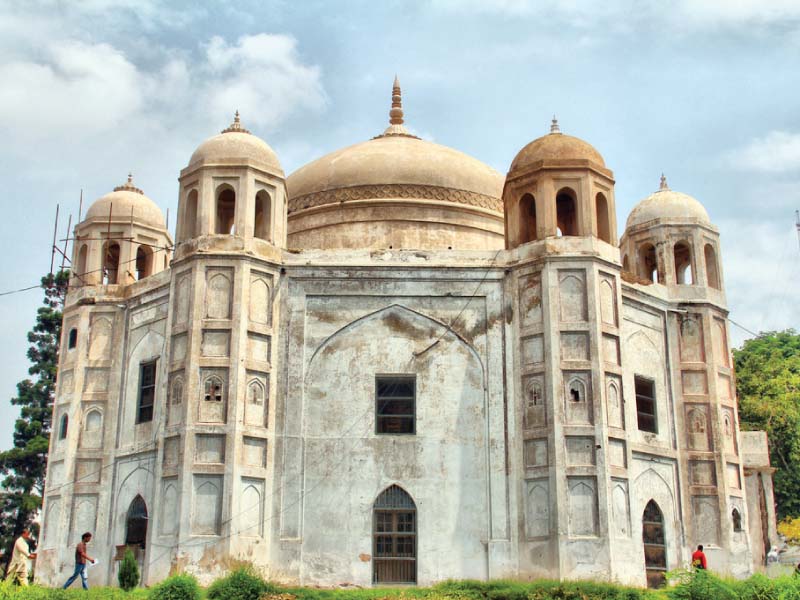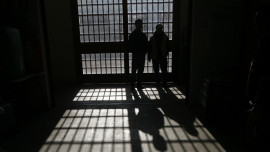
The ingenious eight-sided structure represents infinity, like the timeless tale of love between the courtesan and the prince, according to some historians.
The building also flaunts a marble dome, another important feature of the Islamic structural design, along with a garden, referred to as the Anarkali garden, which was put to several uses over the centuries.
Even with all the changes, the tomb is still a monumental example of the Mughal era, and adds value to the rich history of the provincial capital.
Architectural heritage of Anarkali Bazaar reflects Mughal, British eras
Some historians believe that Anarkali was a member of Emperor Akbar's harem. She was accused by the monarch of luring the crown prince into an illicit relationship. She was later executed over these charges in 1599.
Six years later, Emperor Jahangir, popularly remembered as Prince Saleem, ascended the throne and ordered the construction of a tomb in the memory of his beloved. It was completed in 1615.
The tomb originally stood at the centre of a magnificent garden similar to the plan of the Asif Khan Tomb.
In the early 1800s, the area was occupied by Maharaja Kharak Singh, the son of Maharaja Ranjit Singh, and converted into the residence of General Jean Baptiste Ventura, a French officer in the Sikh army.
Under the British raj, it was reportedly converted into a protestant church in 1851, exactly two years after the British colonized Lahore. It was substantially remodeled and the arched openings were largely blocked off.
Some historians state that the tomb was covered with white paint as opposed to the original red and white colour, when it was converted into a Christian place of worship. A cross was also installed at the top. These were, indeed, the first amendments to the original look of the tomb of Anarkali.
Later on, it was converted to Saint James' Church from 1857 to 1891. Since then, it has been used as Punjab Archives Museum with an amazing collection for those interested in the history of Sikh and British raj in Punjab.
Contradictory accounts are also popular amongst the locals regarding the actual grave of Anarkali, some residents, as well as historians, claim that her grave lies in the premises of Punjab secretariat instead of the tomb.
Similarly, the mystery also surrounds her death. Many assert that she was executed by Emperor Akbar while the rest insist that she died a natural death.
A note from a British traveller, William Finch, who visited Lahore in 1608, three years after Prince Saleem took the reins of the Mughal Empire, reads “The King (Jahangir), in token of his love, commands a sumptuous tomb to be built of stone in the midst of a four-square garden richly walled, with a gate and diverse rooms over it."
However, the traveller failed to provide any other detail; there is a possibility that the note was a figment of his imagination rather than actual history.
Restoration complete: Anarkali’s Tomb ‘returned to its splendour’
“Due to the transition of the building and its controversial history, the events that took place during the rule of Emperor Akbar and Jahangir faded out the actuality of Anarkali and her legacy, whose results can be seen in the diverted thoughts of historians,” a local guide, Sayeed, stated.
He further claimed that people who lived through the Mughal era were equally unaware of the facts, “Hence, the lack of records on the story of Anarkali.”
Sayeed believes that the people were not even allowed to talk about Anarkali and what happened to her as Emperor Akbar and his team wanted to keep her away from the chronicles of the Mughal dynasty.
A local resident, Aslam, said the tomb was maintained and protected during the tenure of former president Musharraf, “Afterwards, nothing was done by the concerned authorities.”
Published in The Express Tribune, December 19th, 2019.

1731570357-0/elon-musk-(1)1731570357-0-165x106.webp)
-(1)1717678110-0/Kendrick-(1)-(1)1717678110-0-165x106.webp)














COMMENTS
Comments are moderated and generally will be posted if they are on-topic and not abusive.
For more information, please see our Comments FAQ